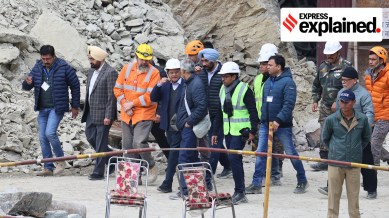What is rat-hole mining, being done to rescue trapped Uttarkashi tunnel workers
Uttarakhand tunnel rescue ops: With large metal pieces hindering machine drilling, the rescuers went ahead with rat-hole mining. Here is what it means.

Efforts to release 41 workers trapped in the collapsed Silkyara-Barkot tunnel in Uttarakhand seemed close to a breakthrough on Tuesday (November 28), after rat-hole miners were reported as being only a few metres away from them.
The National Disaster Management Authority (NDMA) stated on Tuesday, “Once a breakthrough is achieved, the process of pulling out each of the 41 men is estimated to take 3-5 minutes per individual. As a result, the overall operation may extend up to 3-4 hours.”
Jhansi resident Parsadi Lodhi, a rat hole miner who arrived in Silkyara to aid in the rescue operation, said he would enter the rescue pipes and use hand-held tools to dig through the remaining debris blocking the exit to the tunnel.
“I have been doing this work for the last 10 years in Delhi and Ahmedabad. But the work to rescue trapped people will be a first for me… There is no reason for us to be scared. This is a 800 mm wide pipe, and we have worked in 600 mm holes. There is around 12 metres of debris. If its just soil, it will take around 24 hours, but if there are rocks (in the debris), it could take 32 hours or more,” he said.
Vipin Rajput, who also came from Jhansi, said he had been doing rat-hole mining for the last 2-3 years.
What is rat-hole mining?
Rat hole mining is a method of extracting coal from narrow, horizontal seams, prevalent in Meghalaya. The term “rat hole” refers to the narrow pits dug into the ground, typically just large enough for one person to descend and extract coal.
Once the pits are dug, miners descend using ropes or bamboo ladders to reach the coal seams. The coal is then manually extracted using primitive tools such as pickaxes, shovels, and baskets.
OP Singh, professor of environmental studies at North Eastern Hill University (NEHU) in Shillong, told The Indian Express in 2018 that rat-hole mining is broadly of two types. “In the side-cutting procedure, narrow tunnels are dug on the hill slopes and workers go inside until they find the coal seam. The coal seam in hills of Meghalaya is very thin, less than 2 m in most cases,” he said.
In the other type of rat-hole mining, called box-cutting, a rectangular opening is made, varying from 10 to 100 sqm, and through that a vertical pit is dug, 100 to 400 feet deep. Once the coal seam is found, rat-hole-sized tunnels are dug horizontally through which workers can extract the coal.
Environmental and safety concerns
Rat hole mining poses significant safety and environmental hazards. The mines are typically unregulated, lacking safety measures such as proper ventilation, structural support, or safety gear for the workers. Additionally, the mining process can cause land degradation, deforestation, and water pollution.
This method of mining has faced severe criticism due to its hazardous working conditions, environmental damage, and numerous accidents leading to injuries and fatalities. Despite attempts by authorities to regulate or ban such practices, they often persist due to economic factors and the absence of viable alternative livelihoods for the local population.
When was it banned, and why?
The National Green Tribunal (NGT) banned the practice in 2014, and retained the ban in 2015. The NGT observed, “It is also informed that there are umpteen number of cases where by virtue of rat-hole mining, during the rainy season, water flooded into the mining areas resulting in death of many… individuals including employees/workers.”
The order was in connection with Meghalaya, where this remained a prevalent procedure for coal mining. The state government then appealed the order in the Supreme Court.